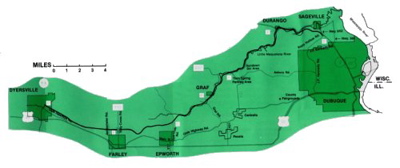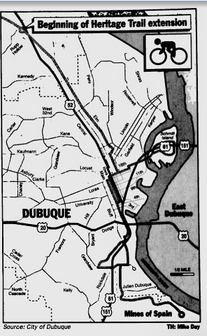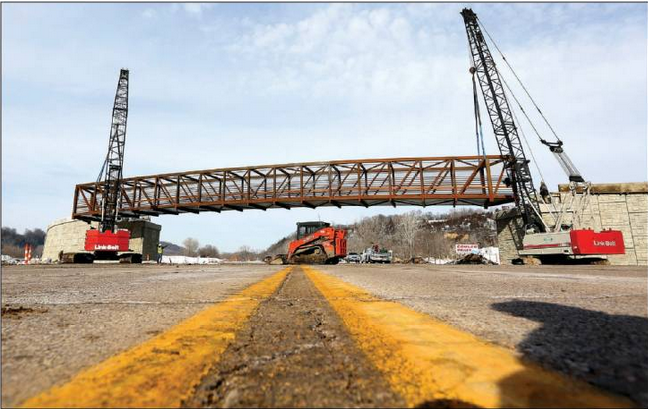Encyclopedia Dubuque
"Encyclopedia Dubuque is the online authority for all things Dubuque, written by the people who know the city best.”
Marshall Cohen—researcher and producer, CNN
Affiliated with the Local History Network of the State Historical Society of Iowa, and the Iowa Museum Association.
HERITAGE TRAIL
HERITAGE TRAIL. The Heritage Trail project was Dubuque County's first sustainable project on a regional scale. (1) Twenty-six miles long with a maximum of one percent grade, the trail of compacted crushed limestone was located on the former right-of-way of the Chicago and Great Western Railroad. When the railroad announced plans to abandon the route, Heritage Trail, Inc., a private, non-profit group, was formed to work with the Dubuque County Conservation Commission to develop a trail. (2) Board members of Heritage Trail, Inc. donated $12,000, WOODWARD COMMUNICATIONS, INC. and FLEXSTEEL INDUSTRIES, INC. contributed, and the Dubuque County Conservation board added $135,000 to complete the $215,000 purchase of the land. (3)
The effort met with strong opposition. Opponents challenged the railroad’s title to the land, argued against spending public money for recreation and voiced fears of trespassing and vandalism. Suspicious fires damaged a half-dozen of the trail's more than thirty wooden bridges. Hog manure was dumped on the trail and barricades were erected. Death threats were received by Arnie Brimeyer, director of the Dubuque County Conservation Board; his successor, Bob Walton; and Mark Ackelson of the Iowa Natural Heritage Foundation. (4)
Trail supporters insured the bridges with a policy from Lloyds of London and hired Pinkerton detective agency personnel to deter trail vandalism. The vandalism and threats ended. (5)
Other obstacles remained. Although records showed that the railroad had clear title to 95 of the 100 parcels of land it had bought in the 1880s, several lawsuits disputed the ownership. Meanwhile, owners of some of the remaining five tracts initially blocked plans for a continuous trail and a plan to extend the trail from Dyersville through Delaware County to Backbone State Park was never pursued because of landowner opposition. (6)
Heritage Trail, Inc., developed parts of the Dubuque County trail where the ownership was not contested; several trail segments opened in 1982. The entire corridor from Dubuque through Sageville, Durango, TWIN SPRINGS, Graf, and Dyersville was completed in 1986, after the Conservation Board negotiated agreements with the remaining landowners. (7) The $400,000 costs of development were paid for through federal and state grants and contributions from over 700 individuals. (8)
The county, seven cities, and the Dubuque Soil and Water Conservation district worked together on a Regional Comprehensive Plan that used the 13 comprehensive planning elements and 10 smart planning principles in the State Code to add sustainability goals and objectives into each of the communities' comprehensive plans. (8)
One of the goals of the Dubuque Smart Planning Consortium was to promote economic development in the region by connecting all seven cities in the Consortium to Heritage Trail. A CPAT offered the Consortium recommendations on how to make the trail more accessible and user friendly, how to promote the sustainability of the Trail, and how to expand the recreational and economic development opportunities of the entire region. (9)
In the fall of 1996 the city received a transportation grant to construct the North End Neighborhood Trail from 32nd to 22nd street along a railroad corridor. Dubuque County received a similar grant to extend Heritage Trail from north of the city limits to 32nd street along a similar corridor.
In October 1996 the city applied for a state transportation grant to extend the trail from E. 22nd Street south to the MINES OF SPAIN STATE RECREATIONAL AREA. The total cost of the project was $461,086. The local share of $138,326 was expected through private donations matched with city money. The 10.6 mile trail, including off-road bike paths, painted lanes on city streets, and routes marked with signs, would connect EAGLE POINT PARK, ZEBULON PIKE LOCK AND DAM, Hawthorne Street Peninsula, Miller-Riverview Park, ICE HARBOR, SHOT TOWER, and Murphy Park.
In the spring of 1997 the Iowa Department of Transportation Commission awarded the city a grant of more than $320,000 for the proposed southern section of the trail. When completed, the entire route would allow people to walk or ride up to 36 miles from Dyersville to the Mines of Spain Recreation Area. (10)
In 2000 bicyclists and runners suggested that the trail be paved. Both groups found the trail difficult to use during the muddy winter and spring seasons. Such an idea found little support among snowmobilers who had been told a hard-surfaced trail would be largely off-limits for their use. (11)
Bob WALTON, executive director of the Dubuque County Conservation Board, was involved in discussions around 2007 that led by 2013 to the overpass over Highway 51 connecting Heritage Trail with the city. Walton and the conservation board which managed the trail wanted a safer path for bicycle riders and walkers.
In 2017 city officials worked on plans to connect the city's trails to John G. Bergfeld Recreation Area and the Mississippi River Trail. By July, 2017 the Whitewater Creek Bridge spanning Bergfeld Pond had been linked to the trail loop in the recreation area and a trailhead and parking area at the northeast corner of the Northwest Arterial and U S. 52 near South John Deere Road had been completed. This trailheadlinked with Heritage Trail to Dyersville. From the same trailhead, a link could be made to the Northwest Arterial trail to the southwest or the Mississippi River Trail south through the North End and Washington neighborhoods to a new Upper Bee Branch trail. City staff also had plans to extend the Northwest Arterial bike trail from Chavenelle Road to Bergfeld Recreation Area. Construction would cost an estimated $1.4 million. (12)
Future plans called for developing a trail along Seippel Road to connect with the Southwest Arterial and then developing a similar trail to the one along the Northwest Arterial. Working with city officials was Tri-State Trail Vision, a nonprofit formed in 2005 through community visioning. (13)
Showcasing the trail and attempting to increase use of the attraction led the Dubuque County Conservation Commission to offer wagon rides pulled by tractor on October 4th between Dubuque and Durango. In 2017 a golf cart tour was offered to those needing help with accessibility. A bus tour along the trail showing different spots was also used in the past. (14)
---
Source:
1. Stone, Larry. "Dubuque County: Heritage Trail: 25 Years Later," Iowa Natural Heritage Foundation. Online: http://www.inhf.org/news/dubuque-heritage-trail-25yrs.cfm
2. Ibid.
3. Ibid.
4. Ibid.
5. Ibid.
6. Ibid.
7. Ibid.
8. "Heritage Trail--Dubuque County, Iowa," APA. Online: https://www.planning.org/communityassistance/teams/dubuque/
9. Ibid.
10. Reber, Craig. "Pedal Pushers on a New Trail," Telegraph Herald, October 5, 1997, p. 8F. Online: https://news.google.com/newspapers?nid=aEyKTaVlRPYC&dat=19971005&printsec=frontpage&hl=en
11. Everly, John. "Paving of Heritage Trail Not Set in Stone," Telegraph Herald, Mar. 4, 2000, p. 4A
12. Barton, Thomas J. "City to Integrate Bike Trail Network," Telegraph Herald, June 21, 2017, p. 1
13. Ibid., p. 2A
14. Fisher, Benjamin, "Wagon Wheels Hit Heritage Trail," Telegraph Herald, October 5, 2019, p. 3A






